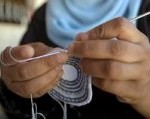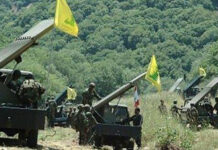 BBC reports: Under the shade of a leafy vine in the occupied West Bank village of Lobban al-Gharbia, three Palestinian women are sitting, knitting and nattering. From the minaret of the next-door mosque, the call to prayer rings out as their fast-moving fingers click the needles at a rapid rhythm.Slowly forming in their laps are three small, round, white pieces of crocheted cloth.
BBC reports: Under the shade of a leafy vine in the occupied West Bank village of Lobban al-Gharbia, three Palestinian women are sitting, knitting and nattering. From the minaret of the next-door mosque, the call to prayer rings out as their fast-moving fingers click the needles at a rapid rhythm.Slowly forming in their laps are three small, round, white pieces of crocheted cloth.
These three Palestinian Muslim women are making one of the most obvious symbols of Jewishness and Judaism – the kippa.
Kippot (as they are known in the plural) are the small domed skullcaps that many Jewish men wear on their heads. Kippa literally means “dome”.
They are often known by their Yiddish name, the yarmulke. It is said kippot are worn to remind people that a Jewish God is above their heads, watching over them.
It is unusual therefore that in Lobban al-Gharbia, there are more than 100 Palestinian Muslim women involved in a kippa cottage industry.
“A job is a job,” says Fatma Abdul Radwan, who has been making kippot to be exported to Israel for more than 30 years.
She says it does not bother her that she is producing goods for Israeli Jews, despite the decades of conflict and the Israeli military occupation.
“Circumstances force you to do some things. We need to make a living in order to live,” Mrs Abdul Radwan says.
She says she is paid eight shekels (just over $2; £1.25) for every kippa she makes. Each one will take her two to three hours. She says she usually makes about 10 kippot a week, earning her around $20. It is not much.
But in Palestinian villages across the West Bank, there are thousands of women working from home in the kippa industry.
“There are over 100 women in our village alone,” says Mrs Abdul Radwan. “We make around 1,000 kippot a week.”
Alongside her, Sadika Husam’s fingers are whirring.
“It’s an easy job,” Mrs Husam says.
“There’s nothing else to do here, and it means we can be at home and look after our children while we do it.”
The United Nations estimates unemployment in the West Bank runs at over 20%.
How the thousands of Palestinian-made kippot make it into Israel is somewhat murky.
Mrs Abdul Radwan says every week or so, she collects up all the handiwork of women across the village and passes it to a middleman.
She did not want to say who, but this man then arranges for the kippot to be delivered to Israel, most likely taken in the back of a car through the checkpoints that separate the West Bank from Israel.
In fact, Israel is the Palestinians’ biggest trading partner.
According to the Palestinian Central Bureau of Statistics, 90% of the $560m worth of goods exported from the West Bank in 2008 were sold to Israel, or via Israel.
“There is a certain irony about kippot being made on the West Bank,” says Ephraim Kleiman, professor of economics at Hebrew University in Jerusalem.
“But actually many goods, such as stone and building materials, vegetables and clothing, are exported to Israel.”
However, Prof Kleiman says Israeli bureaucracy and paperwork can often make exporting Palestinian goods more difficult than it should be.
“We have some kippot made by Palestinians,” says Itzik Sheler, a little sheepishly, who works at the Kippa Man store on the market’s main street.
“They are not as cheap as the Chinese-made ones, but they are cheaper than those made by Israelis.”
He sells white kippot like those made in Lobban al-Gharbia for 15 shekels. Chinese-made kippot sell for as little as seven shekels. The most expensive Israeli-made kippa in his shop sells for 150 shekels.
“The tourists don’t care who makes them,” says Mr Sheler.
Browsing the rows of kippot, I find 23-year-old Heim Segev, an orthodox Jew wearing a smart black velvet kippa.
“I don’t know who made mine,” he says laughing and checking the label.
“I wouldn’t want Hamas to be making it, but if it’s an ordinary Palestinian, I don’t care.”
{BBC/Matzav.com}












Only Kippa Srugas.
who would be so selfish as to save money and let it go to arab murderers and jew haters. someone should do something about that.
This is fine. an increasing level of the general welfare and rising GDP in the State of Israel, Gaza, the West Bank/Judea and Samaria is part of the Redemption. If someone can eke out a living making kippot that is fine. The Israeli economy is humming along although things just might ground to a halt unless certain moves are made. There is great potential for growth however. Regional growth rates could exceed 3% per annum over the next forty years if things are managed well.
A stable, productive, buoyant Holy Land is the desired plan. Competition in the supply of goods and services is a sign of a healthy economy. False restrictions on trade due to political or religious dogma are counterproductive to dynamic growth. The area will not be split into a Settlertown and Westbankistan. Even if this was managed in some bizarre way there would still need to be some form of interaction between the two land masses. I am no longer surprised that people cannot see more than two moves ahead on the cosmic chess board.